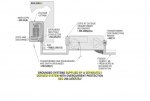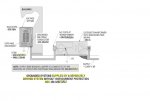250.30 Grounding Separately Derived Alternating Current System
250.32 Buildings or Structures Supplied by a Feeder(s) or Branch circuits(s).
250.32 (B)(2) Supplied by Separately Derived System
250.32 (B)(2)(a) with OCPD
250.32 (B)(2)(b) without OCPD
I don't understand the purpose of 250.32(B)(2). I am thinking, when a separate structure is supplied by a SDS, 250.30 covers the structure's system automatically, regardless of whether utility service or a feeder supplies the source of the SDS.
Let's assume the source of the SDS is a transformer.
Since it's a separately derived system, the separate structure's disconnect will have a system bonding jumper, right? 250.32 (B)(2)(b) says that is correct (it tells me to follow 250.30), but only when the transformer secondary has no OCPD. What does the transformer secondary OCPD has anything to do with whether or not to have a system bonding jumper? 250.32 (B)(2)(a) seems to say that I don't even need to worry about the system bonding jumper if the transformer secondary has OCPD.
I'd appreciate any help/feedback.
250.32 Buildings or Structures Supplied by a Feeder(s) or Branch circuits(s).
250.32 (B)(2) Supplied by Separately Derived System
250.32 (B)(2)(a) with OCPD
250.32 (B)(2)(b) without OCPD
I don't understand the purpose of 250.32(B)(2). I am thinking, when a separate structure is supplied by a SDS, 250.30 covers the structure's system automatically, regardless of whether utility service or a feeder supplies the source of the SDS.
Let's assume the source of the SDS is a transformer.
Since it's a separately derived system, the separate structure's disconnect will have a system bonding jumper, right? 250.32 (B)(2)(b) says that is correct (it tells me to follow 250.30), but only when the transformer secondary has no OCPD. What does the transformer secondary OCPD has anything to do with whether or not to have a system bonding jumper? 250.32 (B)(2)(a) seems to say that I don't even need to worry about the system bonding jumper if the transformer secondary has OCPD.
I'd appreciate any help/feedback.



